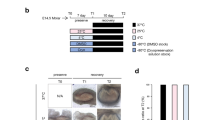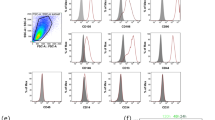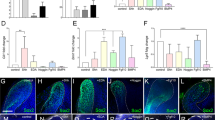Abstract
To bioengineer ectodermal organs such as teeth and whisker follicles, we developed a three-dimensional organ-germ culture method. The bioengineered tooth germ generated a structurally correct tooth, after both in vitro organ culture as well as transplantation under a tooth cavity in vivo, showing penetration of blood vessels and nerve fibers. Our method provides a substantial advance in the development of bioengineered organ replacement strategies and regenerative therapies. Please visit methagora to view and post comments on this article
This is a preview of subscription content, access via your institution
Access options
Subscribe to this journal
Receive 12 print issues and online access
$259.00 per year
only $21.58 per issue
Buy this article
- Purchase on Springer Link
- Instant access to full article PDF
Prices may be subject to local taxes which are calculated during checkout



Similar content being viewed by others
References
Langer, R.S. & Vacanti, J.P. Sci. Am. 280, 86–89 (1999).
Brockes, J.P. & Kumar, A. Science 310, 1919–1923 (2005).
Atala, A. Expert Opin. Biol. Ther. 5, 879–892 (2005).
Pispa, J. & Thesleff, I. Dev. Biol. 262, 195–205 (2003).
Thesleff, I. J. Cell Sci. 116, 1647–1648 (2003).
Tucker, A. & Sharpe, P. Nat. Rev. Genet. 5, 499–508 (2004).
Sharpe, P.T. & Young, C.S. Sci. Am. 293, 34–41 (2005).
Young, C.S. et al. J. Dent. Res. 81, 695–700 (2002).
Ohazama, A., Modino, S.A., Miletich, I. & Sharpe, P.T. J. Dent. Res. 83, 518–522 (2004).
Song, Y. et al. Dev. Dyn. 235, 1334–1344 (2006).
Hu, B. et al. Tissue Eng. 12, 2069–2075 (2006).
Steinberg, M.S. Dev. Biol. 180, 377–388 (1996).
Hata, R.I. Cell Biol. Int. 20, 59–65 (1996).
Salmivirta, K., Gullberg, D., Hirsch, E., Altruda, F. & Ekblom, P. Dev. Dyn. 205, 104–113 (1996).
Acknowledgements
We thank M. Okabe (Osaka University) for providing the C57BL/6-TgN (act-EGFP) OsbC14-Y01-FM131 mice. We are also grateful to K. Itoh and M. Sugai (Kyoto University) for critical reading of this manuscript. We also thank to T. Katakai (Kyoto University) and Y. Nishi (Nagahama Institute of Bioscience and Technology) for their valuable discussions and encouragement. This work was partially supported by an “Academic Frontier” Project for Private Universities to Y.T. and T.T. (2003–2007) and by a Grant-in Aid for Scientific Research in Priority Areas (50339131) to T.T. from MEXT Japan.
Author information
Authors and Affiliations
Contributions
K.N. was involved in each of the experiments described in this study. R.M. analyzed the explants that were formed by a combination of normal and GFP-transgenic mouse-derived cells and performed the immunohistochemical analysis shown in Figure 3. Y.S. performed and analyzed the transplantation experiments in both the subrenal capsule and the tooth cavity. K.I. and M.S. performed the in situ hybridization analysis. Y.T. performed the subrenal capsule transplantation experiments and histological analysis. M.O. maintained the in vitro organ cultures and performed whole-mount analysis of the chimeric bioengineered tooth germ. K.N. and T.T. prepared the manuscript. K.N., M.S., Y.T. and T.T. discussed the results and also contributed to the preparation of this manuscript. T.T. designed the experiments.
Corresponding author
Ethics declarations
Competing interests
The authors declare no competing financial interests.
Supplementary information
Supplementary Fig. 1
Effects of cell density and cell compartmentalization between epithelial and mesenchymal cells upon the generation of bioengineered teeth. (PDF 756 kb)
Supplementary Fig. 2
Three-dimensional histological analysis of bioengineered teeth under various developmental conditions. (PDF 644 kb)
Supplementary Fig. 3
Expression of the regulatory genes that function during early tooth development in a bioengineered incisor tooth germ. (PDF 408 kb)
Supplementary Fig. 4
Generation of a reconstituted whisker in vivo from a bioengineered follicle. (PDF 434 kb)
Supplementary Fig. 5
Development and transplantation of individual primordia. (PDF 416 kb)
Rights and permissions
About this article
Cite this article
Nakao, K., Morita, R., Saji, Y. et al. The development of a bioengineered organ germ method. Nat Methods 4, 227–230 (2007). https://doi.org/10.1038/nmeth1012
Received:
Accepted:
Published:
Issue Date:
DOI: https://doi.org/10.1038/nmeth1012
This article is cited by
-
Genome-wide identification of potential odontogenic genes involved in the dental epithelium-mesenchymal interaction during early odontogenesis
BMC Genomics (2023)
-
Cyclical dermal micro-niche switching governs the morphological infradian rhythm of mouse zigzag hair
Nature Communications (2023)
-
Tooth number abnormality: from bench to bedside
International Journal of Oral Science (2023)
-
Hypes and Hopes of Stem Cell Therapies in Dentistry: a Review
Stem Cell Reviews and Reports (2022)
-
Functional hair follicle regeneration: an updated review
Signal Transduction and Targeted Therapy (2021)



